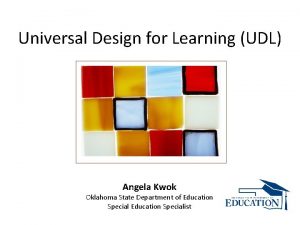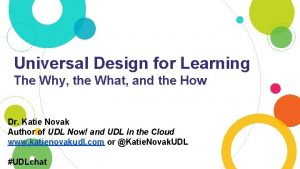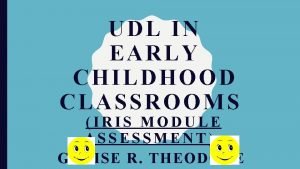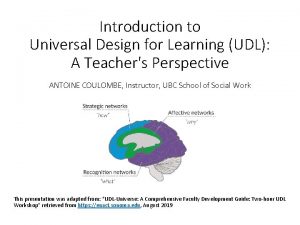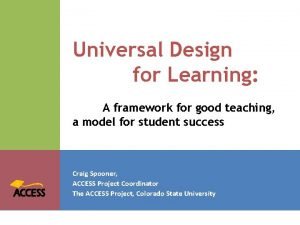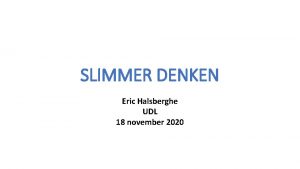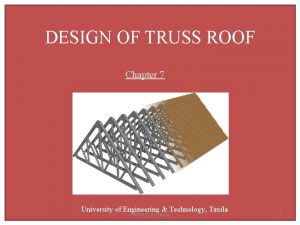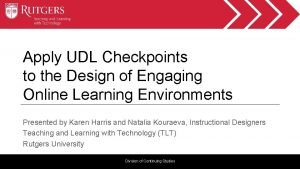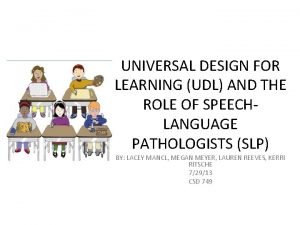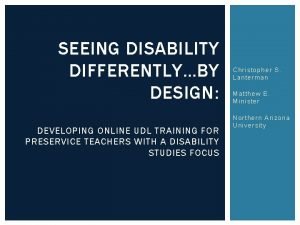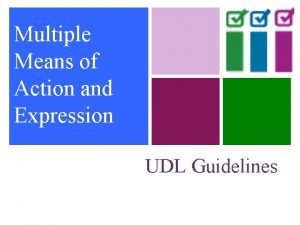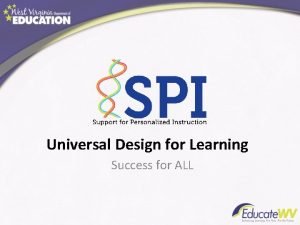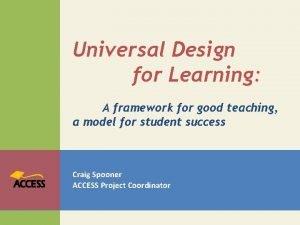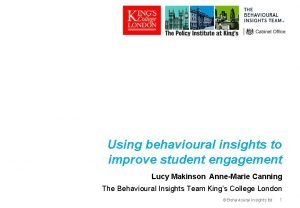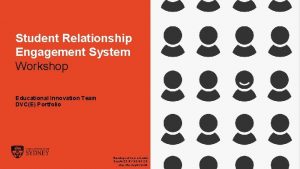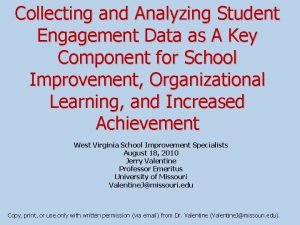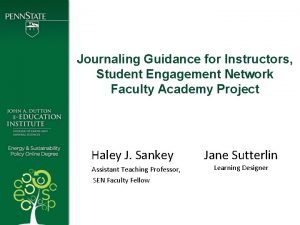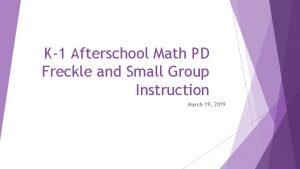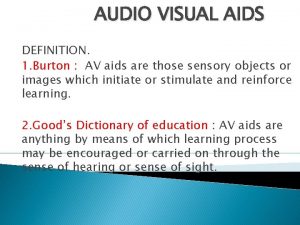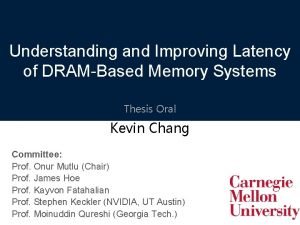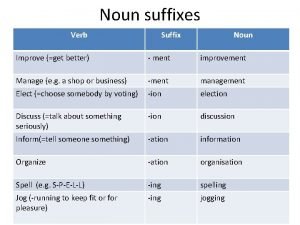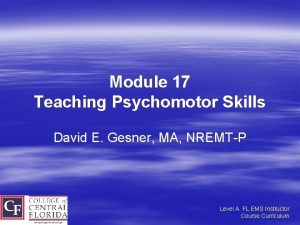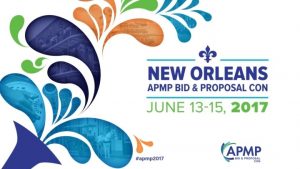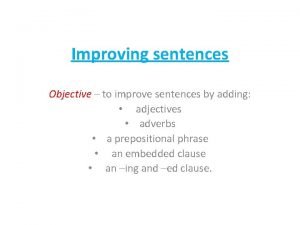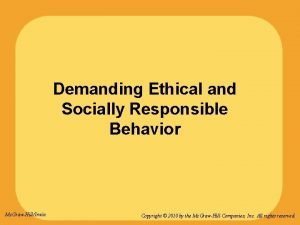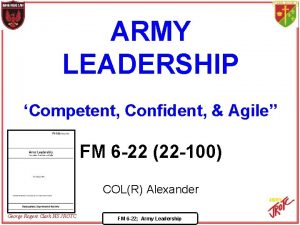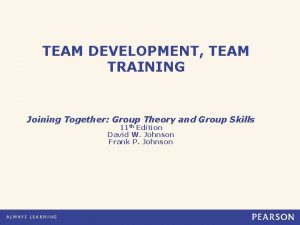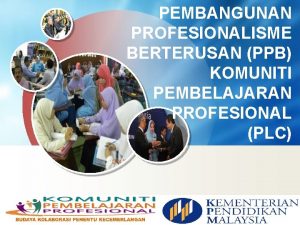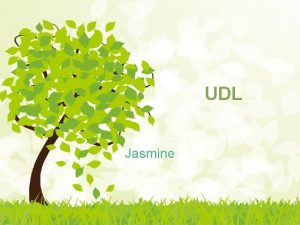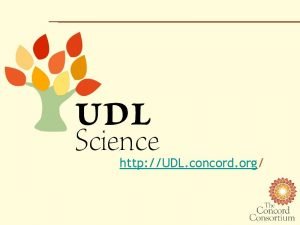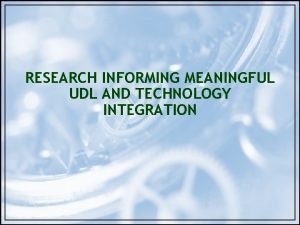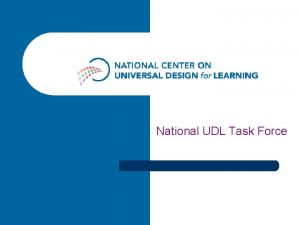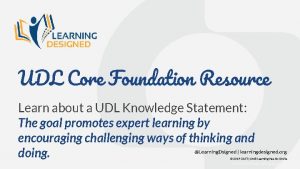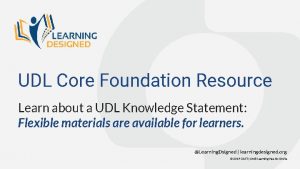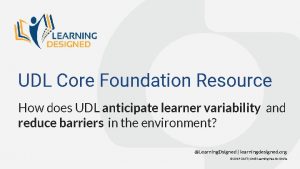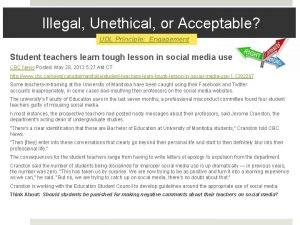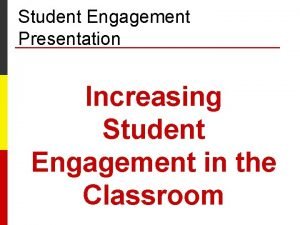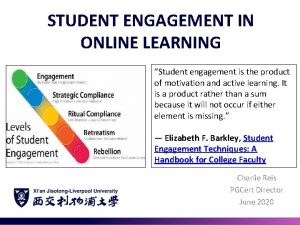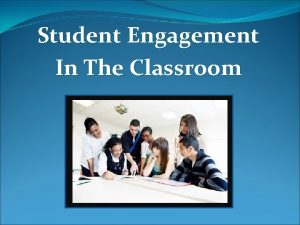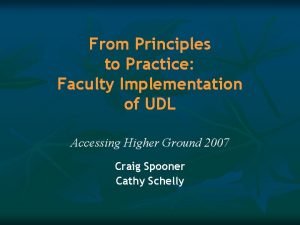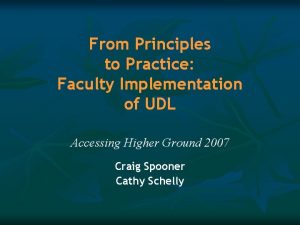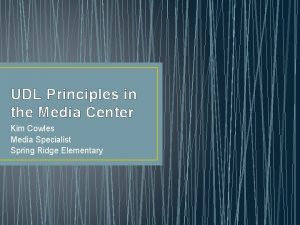USING UDL PRINCIPLES TO IMPROVE STUDENT ENGAGEMENT Sandra

























































- Slides: 57

USING UDL PRINCIPLES TO IMPROVE STUDENT ENGAGEMENT Sandra Law (CLDD) Focused on the future 10 -Dec-2015 of learning.

Polling question • When I mention the term universal design for learning (UDL) what comes to mind?

Agenda • Welcome • What is Universal Design for Learning (UDL)? • Why is UDL important in online distance education at the post-secondary level? • What do we mean by at-risk student? By high-risk courses? • How does engagement fit into UDL and support atrisk students? • Strategies and tools to increase engagement • Questions

What is UDL? • A framework to improve and optimize teaching and learning for all people based on scientific insights into how humans learn. • There are three main principles – Provide multiple means of representation – Provide multiple means of action and expression – Provide multiple means of engagement

UDL guidelines I. Provide multiple means of representation II. Provide multiple means of action and expression III. Provide multiple means of engagement 1. Provide options for perception 4. Provide options for physical action 7. Provide options for recruiting interest • • • Options that increase individual choice and autonomy • Options that enhance relevance, value, and authenticity • Options that reduce threats and distractions Options that customize the display of information • Options that provide alternatives for auditory information • Options that provide alternatives for visual information Options in the mode of physical response Options in the means of navigation Options for accessing tools and assistive technologies 2. Provide options for language and symbols 5. Provide options for expressive skills and fluency • • • Options in the media for communication Options that clarify syntax and structure • • Options for decoding text or mathematical notation • Options that define vocabulary and symbols • Options that promote cross-linguistic understanding • Options that illustrate key concepts nonlinguistically 3. Provide options for comprehension • Options that provide or activate background knowledge (review) • Options that highlight critical features, big ideas, and relationships (concepts map, flowchart) • • Options that guide information processing Options that support memory and transfer 8. Provide options for recruiting interest • Options that heighten salience of goals and objectives Options in the tools for composition and problem solving • Options that vary levels of challenge and support Options in the scaffolds for practice and performance • Options that foster collaboration and communication • Options that increase mastery-oriented feedback 6. Provide options for executive functions • • Options that guide effective goal-setting • Options that facilitate managing information and resources • Options that enhance capacity for monitoring progress Options that support planning and strategy development 9. Provide options for self-regulation • • • Options that guide personal goal-setting and expectations Options that scaffold coping skills and strategies Options that develop self-assessment and reflection

Why is UDL important in online and distance PSE? • Recommends strategies and tools to support a diverse range of students: – With disabilities (e. g. mobility, learning, deaf and hard of hearing, low vision, psychiatric conditions, older adults) – Students with differing types and levels of educational preparation (e. g. international students, indigenous students, refugees, incarcerated students, students with disabilities)

Context for discussion of UDL • Before we get to how UDL can promote engagement amongst at risk students I will provide some context for the discussion – Diverse student body – Some statistics – Distance education context

AU students registered with ASD

AU students registered with ASD in 2011 in 2012 multiple disabilities in 2013 one disability in 2014 0 500 1000 1500 2000 2500

AU students registered with ASD Other Psychiatric Mobility/Functional Blind/Partially Sighted in 2011 in 2012 Learning Disability in 2013 in 2014 Deaf/Hard of Hearing Chronic Medical/Systemic Attention-Deficit I Hyperactivity Disorder Acquired Brain Injury 0 100 200 300 400 500 600 700 800 900

Challenges of distance education • Online communication tools (chat/discussion boards, audio/video conference) • Website and LMS accessibility • Document accessibility • Graphical & multimedia content • ICT function/compatibility • Instructions & study skills

What is an at risk student? • A student is at risk of not achieving academic success if their ‘skills, knowledge, motivation and/or academic ability is significantly below that of the typical student in PSE’ (Maxwell, 1997, p. 2) • These students have ‘low academic selfconcept, unrealistic grade expectations, governed by extrinsic motivation, low selfefficacy, inadequate skills for college success, belief that learning is memorizing and who has a history of passive learning’ (Ender & Wilkie, 2000, p. 134 -135)

Examples of at risk students • Lack necessary preparation for postsecondary study • Have a diagnosed disability but do not disclose (e. g. learning disability)1 • Have an undiagnosed disability • Students with a history of academic failure • Students with emotional or behaviourial problems (e. g. anxious students) • Adult learners returning to PSE after an extended absence • Low motivation/engagement • Lack of psychological attachment to school

Learning Challenge Prototype Reading issues Writing issues Researching issues Connecting background knowledge to new concepts Identifying core ideas/research topics Planning projects With some reading skills, esp. in new content Linking new ideas to prior knowledge Selecting research topics With reading fluency Applying new concepts to examples and new reading Identifying search constructs Comprehension skills Organizing ideas and/or writing Using strategies and tools to efficiently gather information Mastering new vocab. Drafting Organising information Retention Using feedback constructively in revisions Combining components into final product Time and energy use Managing time to complete work by deadline

What is a high risk course? • Online self-paced courses can have high attrition rates. Lack of interaction can lead to reduced student satisfaction and persistence. (Croxton, 2014) • Typically high risk courses have 30% D or F grades or withdrawls (Feldman, 2005).

Inclusive education and student engagement “Disengagement from school – whether a student leaves or struggles through to graduation – is also a significant source of inequity in Canadian society, not only because it places a large number of students at a disadvantage as they move into adult roles, but because disengagement is disproportionately experienced by students living in poverty, students with disabilities, and students from ethnic minority and Aboriginal communities. (p. 7) From Willms et al. (2009, p. 7)

III. Multiple means of engagement Engagement 7. Provide options for recruiting interest • Optimize individual choice and autonomy • Optimize relevance, value, authenticity • Minimize threats and distractions 8. Provide options for sustaining effort and persistence • Heighten salience of goals and objectives • Vary demands and resources to optimize challenge • Foster collaboration and community • Increase masteryoriented feedback 9. Provide options for self-regulation • Promote expectations and beliefs that optimize motivation • Facilitate personal coping skills and strategies • Develop selfassessment and reflection

7. Provide options for recruiting interest • Optimize individual choice and autonomy – Practice opportunities, reward type, information gathering/production, design/layout of graphics, sequence for completing tasks • Optimize relevance, value and authenticity – Personalization, relevance to individual learner, culturally and socially relevant, supports diversity • Minimize threats and distractions – Accepting environment, vary level of novelty and risk, vary level of sensory stimulation

Individual choice and autonomy • Self-quizzes or exams (with immediate and helpful feedback) • Flexible assignments (e. g. open-ended assignments) • RSS feeds give students freedom to explore a topic

Optimize relevance, value & authenticity • Authentic activities (contextualized to learner’s life) • Include tasks that allow learners to actively participate and reflect on their learning (e. g. journals, blogs) • Design activities that allow learners to engage in creative problem-solving (e. g. real world problems in mathematics) • Appropriate for diverse audiences

Example - Simulation • Ardcalloch simulation

Examples of authentic learning activities • • • Problem-based learning Case studies Simulation & role play Literature reviews Portfolios

Minimize threats & distractions • Ambiguity. Novices generally have a low tolerance for ambiguity and making mistakes (Cox, 2009). • Consistency of presentation (e. g. between courses) • In paced courses use calendars and schedules to increase predictability of activities • Use advanced organizers to help learners anticipate what is coming • Introducing novel experiences can help motivate learners to maintain interest

8. Provide options for sustaining effort and persistence • Heighten salience of goals and objectives – Achievable goal setting, scaffolding to visualize desired outcome, exemplars • Vary demands and resources to optimize challenge – Flexibility in tools, emphasize process, rubrics • Foster collaboration and community – Group work ground rules, support learning communities • Increase mastery-oriented feedback – Encourage self-awareness, provide targeted & substantive feedback, identify success strategies

Example – Mind Map

Example – Concept Map

Heighten salience of goals and objectives • Guide students to set realistic learning goals around their work and personal lives. • Direct students to time management resources by including HTML blocks with links • Encourage students to use scheduling apps to send themselves reminders of assignment deadlines • Use calendar in the LMS to sync the individual’s start date to recommended milestones • Provide exemplars of excellence • Provide rubrics that make goals and objectives of activities and assignments more explicit

Example – HTML Block

URLs for rubrics • • Online discussion Projects (e. g. sciences) Collaboration Lab reports Mathematical proofs E-portfolios Research paper

Example – Mathematical proof rubric

Vary demands and resources to optimize challenge • Engage most able students as well as those less able by – Offering certain number of flexible, open-ended assignments – Flexible deadlines (built into the self-paced environment) • Use question and assignment banks with variable levels of difficulty and complexity • Don’t insist that students use particular tool to complete assignment (unless necessary for instructional / learning goals)

Foster community and collaboration • Difficult but not impossible especially for high enrollment self-paced courses – Encourage students to work with study buddies or groups – Provide guidelines for students if they are expected to work in groups – Encourage students to develop learning networks outside the course (e. g. volunteer in community, join professional organization, interact with an expert) – Encourage students to form special interest group in courses allowing students to join like-minded individuals

Learning Networks - NOAA

Tools that can support collaboration • Game-based learning and participatory research apps and sites • Asynchronous discussion forums in LMS. Instructors and tutors can model effective communication with their postings (Croxton, 2014; Gunawardena, 2010) • Course or program group on the Landing or website • Special Interest Groups (SIGs) in courses facilitated through groupings and signup sheets in Moodle • Group project collaboration through Moodle wikis, Google Docs, Skype, etc.

ete. RNA

XMind

Example – Learning Communities

Increase mastery-oriented feedback • Provide detailed and strategic feedback for assessments: – Automatically self-tests using Moodle quiz features – Use comments feature in the assignment drop box (try using alternate formats, e. g. recording audio feedback) • Focus on providing feedback that identifies patterns of errors and guides learners towards positive strategies for success

Carol Dweck’s Comments “Students who are mastery-oriented think about learning, not about proving how smart they are. When they experience a setback, they focus on effort and strategies instead of worrying that they are incompetent. ” URL of transcript of interview with C. Dweck

9. Provide options for selfregulation • Promote expectations and beliefs that optimize motivation – Provide prompts and reminders to increase ontask orientation, provide coaches/pedagogical agents that model goal setting • Facilitate personal coping skills and strategies – Provided differentiated scaffolds and feedback to minimize frustration, help students to develop internal controls • Develop self-assessment and reflection – Provide tools that allow students to monitor their own behaviour (e. g. charts, aids)

Promote expectations that optimize motivation • Provide learners with rubrics and checklists that promote an on-task orientation • Include assessments that require students to set goals and engage in self-reflection (e. g. blogging or journaling) • Model the process of goal-setting (e. g. as a mentor in a graduate level course)

Facilitate Personal Coping Skills / Strategies • Provide models, scaffolds and feedback to reduce – Frustration – Equip students with coping skills • AU has resources – Provide links to these resources in your courses (e. g. HTML block linking to various student services like study skills, time management, writing skills)

Range of student services / supports

Link to AU Resources • Study Skills – Time management – Study schedule – Goal setting – Note taking • LSS – Counselling, ASD, Advising • Library tutorials • Math Site • Write Site • Program websites • Student Success Centre

Develop self-assessment and reflection • Progress tracking can help students to maintain motivation (because they can see what they have accomplished and what they still have to do) • Use templates (progress tracking, goalsetting) to help students become more effective learners. • Learner journals or blogs in Moodle or on Landing

Academic Time Budget

Procrastination Management

Polling question • Can you think of ways that you might incorporate UDL in your courses. Could you give an example?

UDL – Not an extra burden “… UDL is not an extra burden. Rather I would say that universal design for learning helps you maintain a high level of expectation and assessment and at the same time it helps students to reach those high standards and to achieve greater learning outcomes. ” Dr. Sandra Yang, Cal Poly Pomona on applying UDL in her course “Introduction to Music”

Impact UDL Conference • Some great keynotes will be delivered by experts in the field like Sam Johnston • Features work of your colleagues at AU and other Alberta post-secondary institutions • Benefit from the experience of academics, professionals and service personnel from other provinces within Canada and the US. • Remember to register for the conference @ http: //udl. athabascau. ca

For more information about Impact UDL Conference: • Sandra Law – slaw@athabascau. ca • Carrie Anton – carriea@athabascau. ca

Any questions?

Resources • • UDL on Campus – CAST Washington University DO-IT Accessible Campus – Council of Ontario Universities UDL-Universe National Centre for Accessible Media CLDD Accessibility Guidelines ASD Office Athabasca University Landing Accessibility Group

References • Canadian Council on Learning. (2007). Equality in the classroom: The educational placement of children with disabilities. Retrieved from http: //www. cclcca. ca/CCL/Reports/Lessons. In. Learning/Lin. L 20070502 _Disability_Provincial_differences. html • Croxton, R. A. (2014). The role of interactivity in student satisfaction and persistence in online learning. MERLOT Journal of Online Learning and Teaching, 10(2), 314 -324. • Ender, S. C. and Wilkie, C. J. (2000). Advising Students with Special Needs. In V. N. Gordon, W. R. Habley, & Associates (Eds. ), Academic Advising: A comprehensive handbook (pp. 118 -143). San Francisco: Jossey-Bass. - See more at: http: //www. nacada. ksu. edu/Resources/Clearinghouse/View. Articles/At-Risk-Students. aspx#sthash. 1 Kf. Uy. Vaf. dpuf

References (con’d) • Feldman, R. S. (2005). Improving the First Year of College: Research and Practice. Lawrence Erlbaum Associates: Mahwah, NJ, USA. • Gradel, K. & Edson, A. J. (2009 -2010). Putting universal design for learning on the higher ed agenda. Journal of Educational Technology Systems, 38(2), 111 -121. • Gunawardena, C. N. Linder-Van. Berschot, J. A. , La. Pointe, D. K. & Rao, L. (2010). Predictors of learner satisfaction and transfer of learning in a corporate online education program. American Journal of Distance Education, 24(4), 207 -226. doi: 10. 1080/08923647. 2010. 522919

References (con’d) • Kraglund-Gauthier, W. L. , Young, D. C. & Kell, E. (2014). Teaching students with disabilities in post-secondary landscapes: Navigating elements of inclusion, differentiation, universal design for learning, and technology. Transformative Dialogues: Teaching & Learning Journal, 7(3), 1 -9. • Lee, E. , Pate, J. A. * Cozart, D. (2015). Autonomy support for online students. Tech. Trends: Linking Research & Practice to Improve Learning, 59(4), 54 -61. DOI: 10. 1007/s 11528 -015 -0871 -9. • Maxwell, M. (1997). Improving Student Learning Skills. Clearwater FL: H & H Publishing. - See more at: http: //www. nacada. ksu. edu/Resources/Clearinghouse/View. Articles/At-Risk-Students. aspx#sthash. 1 Kf. Uy. Vaf. dpuf

Resources (con’d) • Willms, J. F. , Friesen, S. , & Milton, P. (2009). What did you do in school today? Transforming classrooms through social, academic, and intellectual engagement. (First National Report) Toronto: Canadian Education Association.
 Difference between udl and differentiation
Difference between udl and differentiation Mtss and udl
Mtss and udl Iris module udl
Iris module udl Strain energy formula for torsion
Strain energy formula for torsion Explain the process of udl.
Explain the process of udl. Udl book builder
Udl book builder Udl nontraditional students
Udl nontraditional students Udl voorbeelden
Udl voorbeelden Weight of truss formula
Weight of truss formula Udl checkpoints
Udl checkpoints Universal design for learning definition
Universal design for learning definition Udl
Udl Multiple means of action and expression
Multiple means of action and expression Iris udl assessment answers
Iris udl assessment answers Udl percentage
Udl percentage Fce udl
Fce udl Student engagement insight
Student engagement insight Education innovation usyd
Education innovation usyd Australasian survey of student engagement
Australasian survey of student engagement Student engagement data collection
Student engagement data collection Student engagement presentation
Student engagement presentation Student engagement network
Student engagement network What did you do last weekend conversation
What did you do last weekend conversation What did they do last weekend
What did they do last weekend National clearinghouse student tracker
National clearinghouse student tracker Class maths student student1 class student string name
Class maths student student1 class student string name National student clearinghouse student tracker
National student clearinghouse student tracker Student freckle math
Student freckle math Teacher good morning class
Teacher good morning class Student learning soace
Student learning soace Chapter 23 using recipes
Chapter 23 using recipes System collections generic
System collections generic Defrost using internal heat is accomplished using
Defrost using internal heat is accomplished using Av aid
Av aid Elements and principles of art
Elements and principles of art How to improve marketing performance
How to improve marketing performance Improve memory latency
Improve memory latency Intrapersonal and interpersonal difference
Intrapersonal and interpersonal difference Restore and improve urban infrastructure
Restore and improve urban infrastructure Roce investopedia
Roce investopedia Suffix of improve
Suffix of improve Stupid suffixes
Stupid suffixes How to improve psychomotor skills
How to improve psychomotor skills If you can't measure it it doesn't exist meaning
If you can't measure it it doesn't exist meaning Kiss model keep improve start stop
Kiss model keep improve start stop Improving software economics
Improving software economics Improving sentences
Improving sentences Call in 3. hali
Call in 3. hali Www.reachoutworld.org/amc
Www.reachoutworld.org/amc How to improve current ratio
How to improve current ratio Fm 6-22
Fm 6-22 How did the hongwu emperor improve life for the peasants?
How did the hongwu emperor improve life for the peasants? Joining together as a team to improve the quality
Joining together as a team to improve the quality Terminal server load simulator
Terminal server load simulator What is the difference between spirituality and religion
What is the difference between spirituality and religion Strategi improve dalam plc
Strategi improve dalam plc How to monitor and improve workplace operations
How to monitor and improve workplace operations How to improve yourself spiritually
How to improve yourself spiritually
